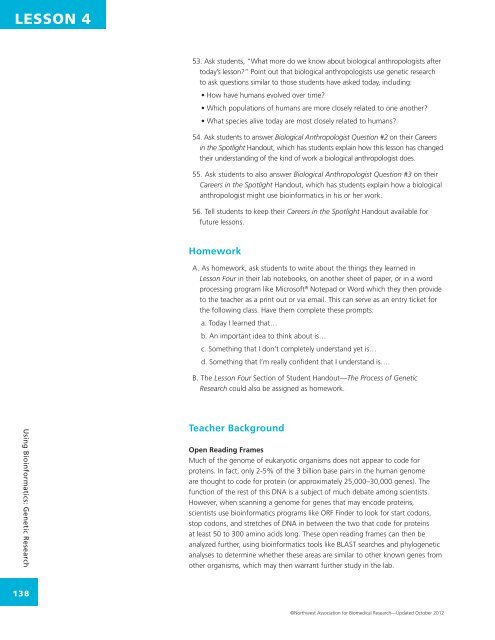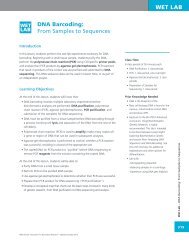<strong>LESSON</strong> 453. Ask students, “What more do we know about biological anthropologists after<strong>to</strong>day’s lesson?” Point out that biological anthropologists use genetic research<strong>to</strong> ask questions similar <strong>to</strong> those students have asked <strong>to</strong>day, including:• How have humans evolved over time?• Which populations of humans are more closely related <strong>to</strong> one another?• What species alive <strong>to</strong>day are most closely related <strong>to</strong> humans?54. Ask students <strong>to</strong> answer Biological Anthropologist Question #2 on their Careersin the Spotlight Handout, which has students explain how this lesson has changedtheir understanding of the kind of work a biological anthropologist does.55. Ask students <strong>to</strong> also answer Biological Anthropologist Question #3 on theirCareers in the Spotlight Handout, which has students explain how a biologicalanthropologist might use bioinformatics in his or her work.56. Tell students <strong>to</strong> keep their Careers in the Spotlight Handout available forfuture lessons.HomeworkA. As homework, ask students <strong>to</strong> write about the things they learned inLesson Four in their lab notebooks, on another sheet of paper, or in a wordprocessing program like Microsoft ® Notepad or Word which they then provide<strong>to</strong> the teacher as a print out or via email. This can serve as an entry ticket forthe following class. Have them complete these prompts:a. Today I learned that…b. An important idea <strong>to</strong> think about is…c. Something that I don’t completely understand yet is…d. Something that I’m really confident that I understand is….B. The Lesson Four Section of Student Handout—The Process of GeneticResearch could also be assigned as homework.<strong>Using</strong> <strong>Bioinformatics</strong>: Genetic ResearchTeacher BackgroundOpen Reading FramesMuch of the genome of eukaryotic organisms does not appear <strong>to</strong> code forproteins. In fact, only 2-5% of the 3 billion base pairs in the human genomeare thought <strong>to</strong> code for protein (or approximately 25,000–30,000 genes). Thefunction of the rest of this DNA is a subject of much debate among scientists.However, when scanning a genome for genes that may encode proteins,scientists use bioinformatics programs like ORF Finder <strong>to</strong> look for start codons,s<strong>to</strong>p codons, and stretches of DNA in between the two that code for proteinsat least 50 <strong>to</strong> 300 amino acids long. These open reading frames can then beanalyzed further, using bioinformatics <strong>to</strong>ols like BLAST searches and phylogeneticanalyses <strong>to</strong> determine whether these areas are similar <strong>to</strong> other known genes fromother organisms, which may then warrant further study in the lab.138©Northwest Association for Biomedical Research—Updated Oc<strong>to</strong>ber 2012
<strong>LESSON</strong> 4Glossary5’ and 3’: The 5’ region is the beginning of the DNA or RNA strand, while the 3’ region is the end of the DNA or RNA strand.Scientists often say that DNA is “read 5’ <strong>to</strong> 3’” which means that the sequence is read or examined from the beginning (5’) <strong>to</strong>the end (3’). Genes are also transcribed and translated in a 5’ <strong>to</strong> 3’ direction.Acidic: Side chains of amino acids that can act as a pro<strong>to</strong>n donor (-COOH) and give up a hydrogen, leaving a negativelycharged side chain (-COO - ). Acidic amino acids are negatively charged.Amino acid: Amino acids are the building blocks of proteins. Every amino acid contains an amino group and a carboxylic acidgroup (which is why they are called “amino acids”). Each amino acid also contains a unique side chain or R-group, which givesthe amino acid its chemical properties (such as hydrophobic, hydrophilic, acidic, or basic). There are 20 different amino acidsspecified by the genetic code. In a protein, amino acids are joined <strong>to</strong>gether by bonds between the amino and carboxyl groups.Anti-parallel: DNA strands are “anti-parallel” <strong>to</strong> one another, meaning they are parallel (or side-by-side), but run in oppositedirections, with the beginning (or 5’ region) of one DNA strand found at the same location as the end (or 3’ region) of theopposite DNA strand.Anti-sense strand: Of the two DNA strands, the anti-sense strand is the one that is complementary <strong>to</strong> the strand thatencodes a gene. This strand is used <strong>to</strong> make the mRNA. Also called the template or non-coding strand.Basic: Side chains of amino acids that contain chemical groups, like amino groups (-NH 2 ), that can accept a hydrogen (-NH3+).Basic amino acids are positively charged.Coding strand: Of the two DNA strands, the coding strand is the strand that has the same sense as the messenger RNA.We can use the DNA sequence from the coding strand <strong>to</strong> predict a protein sequence by looking at the genetic code. Thisstrand is the same sequence as the mRNA. Also called the sense strand. Only one strand is used for one gene, but differentstrands can encode different genes.Codon: Series of three nucleotides in a row that specifies the genetic code information for a particular amino acidwhen translating a gene in<strong>to</strong> protein. For example, the codon CCG codes for the amino acid proline (P). Also called anucleotide triplet.Complementary: Complementary bases are two bases that are able <strong>to</strong> pair with each other and create a base pair. In DNA,adenine (A) and thymine (T) are complementary, and the A on one DNA strand interacts with the T on the opposite (orcomplementary) DNA strand <strong>to</strong> form a bond <strong>to</strong> complete double stranded DNA. Similarly, guanine (G) and cy<strong>to</strong>sine (C) arecomplementary because they always interact with one another. This complementary interaction happens between each baseon the DNA strands.Consensus: Consensus means “agreement,” and is used in bioinformatics <strong>to</strong> describe a case where two or more aligned DNAor protein sequences have the same amino acid or nucleotide in a given position. In the words “CAT” and “BAT,” the “AT” ineach word is in consensus.Conservative: When amino acid changes observed between two or more sequences do share the same side chain orR-group chemistry.Direct-<strong>to</strong>-Consumer (DTC) genetic testing: Sometimes referred <strong>to</strong> as at-home genetic testing, direct-<strong>to</strong>-consumer genetictests are genetic tests marketed directly <strong>to</strong> the consumer without necessarily involving a doc<strong>to</strong>r or insurance company.Gene: The unit of heredity. A segment of DNA that codes for a specific protein.Hydrophilic: A substance that is attracted <strong>to</strong> water. From the Greek “hydro,” which means water, and “philos” meaning love.A synonym for polar. The opposite of hydrophobic or non-polar.Hydrophobic: A substance that repels water. From the Greek “hydro,” which means water, and “phobos,” which means fear.A synonym for non-polar. The opposite of hydrophilic or polar.Lesson 4 – <strong>Using</strong> <strong>Bioinformatics</strong> <strong>to</strong> <strong>Analyze</strong> <strong>Protein</strong> <strong>Sequences</strong>139©Northwest Association for Biomedical Research—Updated Oc<strong>to</strong>ber 2012
















